Dear Readers,
This, our 50th monthly issue, will be the last issue of AgriTech News. We have come to the sad, but inevitable, conclusion that given its limited readership, indicated by the number of visits to this website, continuing the newsletter is hardly commensurate with the effort that goes into producing it. Our website will continue to carry the other regular features, such as Blogs, Perspectives, Technical Briefs, and Papers and Presentations. We thank the readers of ATNL for their support thus far.
— Editor
Research Results
1. A reliable way identified to downregulate gene translation in plants
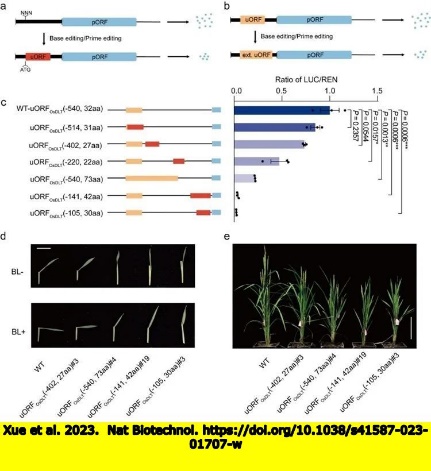
The development of plant genome editing and its use has transformed crop breeding. For breeding new and desired features into crops, techniques for fine-tuning gene expression, based on specific genome alterations, are essential. Gene transcription is completely prevented by widely used gene editing methods—such as CRISPR-Cas, CRISPR interference, and RNA interference—or it is reduced to a specific but unpredictable degree. By carefully constructing upstream open reading frames, Caixia Gao and colleagues at the Chinese Academy of Sciences have developed a new technique for downregulating (Editor’s note: downregulation involves suppression of gene transcription and/or translation to a protein) gene translation to a predictable and desirable level in plants. This strategy can help researchers to modulate endogenous translational gene expression reliably, going step-by-step, and it would further improve methods to control gene activity.
Using this strategy, the researchers proposed two methods to inhibit gene translation: (1) inserting de novo upstream open reading frames (uORFs) into the 5′ untranslated region of the target gene, and (2) modifying the stop codons of endogenous uORFs to increase their ability to inhibit gene translation. The researchers were able to create mutant rice plants with new and expanded uORFs. Using precise genome editing techniques, such as core editors and master editors, researchers were able to create mutant rice plants with new and higher uORF values. These methods provide an efficient way to get genome-edited plants with a range of expressions of traits. The researchers have thus created an effective and widely applicable strategy to regulate gene translation in plants to predictable and desired levels, using uORF technology, which will significantly improve crops in the future.
For more, see https://www.azolifesciences.com/news/20230310/A-reliable-way-to-downregulate-gene-translation-in-plants.aspx
Access the abstract at https://www.nature.com/articles/s41587-023-01707-w
2. A blocking gene that inhibits root growth may enhance drought resistance in crops
Well, in our last issue, you read about longer roots for drought resistance. Now, here is a report on a gene that inhibits root growth. A strong root system enables crop plants to absorb water and nutrients from the soil. However, scientists know very little about the genes that regulate root development. A recent study by Zichao Li and his team at the China Agricultural University, Beijing, shows that inhibition of a negative regulatory gene for root development results in increased plant root growth. The gene, called ROBUST ROOT SYSTEM 1 (RRS1), encodes an R2R3-type MYB family transcription factor, which activates the expression of another gene that suppresses root growth.

Deletion of RRS1 in plants resulted in longer root length, longer lateral root length, and higher lateral root density. A natural variant of RRS1, which alters the activity of the RSS1 protein, had similar beneficial effects on roots. These results indicate that suppressing the normal expression of RSS1 can improve drought tolerance in crops by promoting water absorption. Knocking out of RRS1 enhances drought resistance by promoting water absorption and improving water-use efficiency. The researchers conclude that this study provides a new gene resource for improving root systems, and for thus cultivating drought-resistant rice varieties, with important values in agricultural applications.
Access the abstract at https://nph.onlinelibrary.wiley.com/doi/10.1111/nph.18775
3. Helping plants grow as phosphorus levels in the soil get depleted
Much of the massive increase in agricultural production can be attributed to the application of chemical fertilizers. Nitrogen has been mainly responsible for the production increase, and phosphorus also plays a major role. However, as there has been an overuse of fertilizers during the past few decades, especially in some European countries and in North America, it is feared that the naturally occurring phosphorus may now be scarce. Hence, there is a need to identify the role of phosphorus more clearly in plant growth. Researchers at the Michigan State University and the Carnegie Institution for Science, led by Seung Rhee, have discovered something that changes the understanding of low phosphorus-induced iron toxicity in plants.
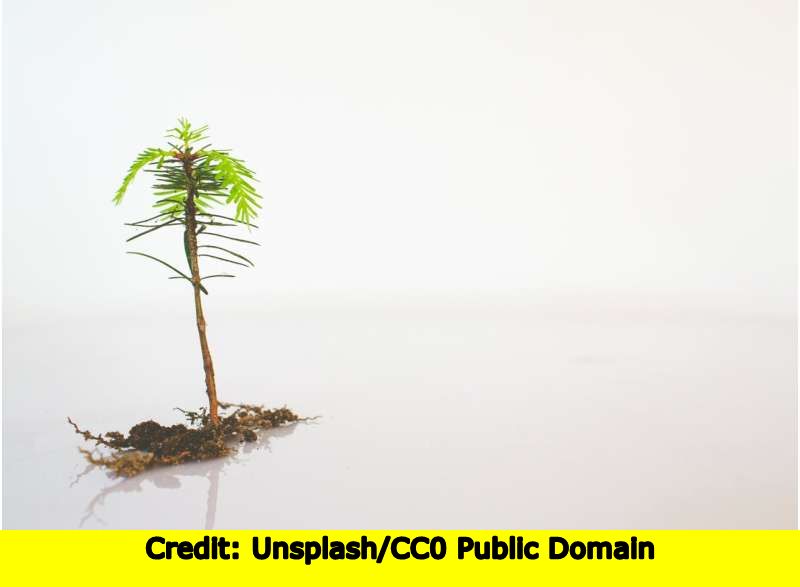
When the world’s supply of phosphorus is dwindling, we should be able to raise crops with minimal application of phosphorus to grow plants. If the soil does not contain enough phosphorus, plants take more iron from the soil, which becomes toxic in larger quantities. Researchers have identified an Arabidopsis root-specific kinase 1 (ARSK1) that represses the initiation of root growth in response to P limitation. They show that ARSK1 phosphorylates and stabilizes the target of rapamycin (TOR) regulatory protein 1B (RAPTOR1B), a component of TOR complex 1, to regulate root growth to P availability. These findings indicate signalling components that act upstream of TOR to balance growth and P availability .”This is the first time anyone has linked phosphorus deficiency signalling to TOR kinase in vascular plants,” Rhee said. “We want to design plants whose roots will continue to grow despite phosphorus limitation.”
For more, see https://phys.org/news/2023-03-phosphorus-soil-deplete.html?utm_source=nwletter&utm_medium=email&utm_campaign=daily-nwletter
Access the abstract at https://www.cell.com/current-biology/fulltext/S0960-9822(23)00291-9?_returnURL=https%3A%2F%2Flinkinghub.elsevier.com%2Fretrieve%2Fpii%2FS0960982223002919%3Fshowall%3Dtrue
4. Genes in beans: Bean genome sequenced in efforts to improve nutritionThere has been a spurt in the efforts to produce ‘fake meat’ to significantly reduce emissions of greenhouse gases and the loss of biodiversity caused by a meat-rich diet. Although this is debatable (see https://sightandlife.org/blog/plant-based-meat-and-environmental-sustainability-a-complex-story/), it is important to ensure that a large proportion fake meat is made using locally produced plant protein. However, the production of vegetable protein is hindered by the lack of cool vegetables, comparable to soybeans in terms of crop value. In this scenario, bean (Vicia faba L.) has a high yield potential and is well suited for cultivation in temperate climates, but genomic resources are scarce. The faba bean genome, which at 13 billion bases is more than four times the size of the human genome, has been sequenced for the first time and published in Nature.
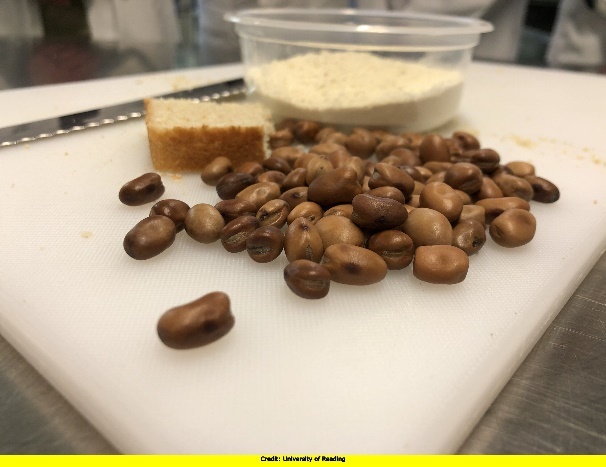
Faba beans are naturally high in protein, fibre, and iron-all nutrients. A consortium of scientists from Europe and Australia, led by the University of Reading (UK), Aarhus University (Denmark), and the University of Helsinki (Finland), worked together to fully decode the genome, and they went on to test its usefulness by searching for genes involved in seed size. The research team checked the colour of the hilum-the scar (a scar that forms on the bean when it detaches from the pod) to understand genes that determine this distinctive trait. The aim was to produce beans that are higher in essential amino acids, as well as lower in antinutrients, such as phytate, which binds to micronutrients and reduces absorption. The researchers expect that faba bean genome sequencing will accelerate this process considerably. The resources presented constitute a genomics-based breeding platform for the faba bean, enabling breeders and geneticists to accelerate the improvement of sustainable protein production across the Mediterranean, and in subtropical and northern temperate agroecological zones.
Access the full paper at https://www.nature.com/articles/s41586-023-05791-5
5. Decoding the genetics behind plant height and seed weight scaling in barley
In living beings, including plants, biological functions, resource availability, and evolutionary processes often play a key role in determining the expression of genetic traits and their correlations. Several plant traits are usually correlated, owing to different ecological factors. One example of such correlated traits is plant height and seed size. There are several conceptual arguments to explain the mechanism of plant allometric scaling, including the hypothesis that modern crop breeding and domestication may alter the development and expression pattern of plant height and seed weight. A recent study by Australian researchers identified potential genetic factors underlying the relationship between barley height and seed weight. Chengdao Li and his colleagues at Murdoch University, Australia, analysed phenotypic data on plant height and seed weight in 12,828 barley samples, containing both domesticated and wild barley, a high-density genome-wide SNP data set.
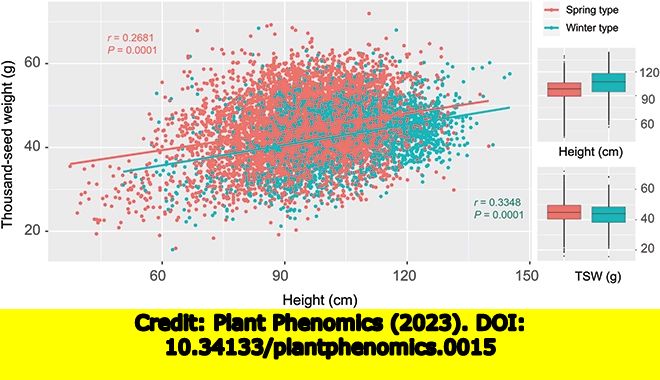
In addition to the usual correlation, the team noted that the domesticated barley plants are shorter and have smaller seeds than wild barley, suggesting that plant height and seed weight were less influenced by direct artificial selection. These results indicate that there are two separate genetic mechanisms involved in determining plant height and seed weight, and the genes involved affect diverse traits related to plant growth and development. They thus provide a better understanding of the genetic factors underlying size scaling, which in turn may expand opportunities to investigate other mechanisms underlying allometric scaling in plants. Although the study examined size scaling only in one crop, it suggests similar genomic mechanisms for allometric scaling in other plant species. The findings help to gain a better understanding of the heritability and genetic basis of size scaling, and thus open a new venue for seeking the underlying mechanism of allometric scaling in plants. Since the size scale in barley is positively correlated, genetically limited, and minimally affected by domestication, the results of this study may have possible implications for breeding crops where correlated traits are desired in the opposite direction.
For more, see https://phys.org/news/2023-03-decoding-genetics-height-seed-weight.html
Access the full paper at https://spj.science.org/doi/10.34133/plantphenomics.0015
6. Leaf-like photosynthesis discovered in the roots of a leafless orchid
As most of us know, photosynthesis is the process by which green plants combine carbon dioxide and water into food, using energy from sunlight to survive and grow. This process occurs mostly in leaves, which contain the chlorophyll pigment. This green pigment is essential for photosynthesis because it absorbs light. However, some plants have developed unusual ways of carrying out photosynthesis. Recently, Professor Suetsugu Kenji and colleagues at Kobe University, Japan, discovered that a leafless epiphytic orchid could conduct sophisticated photosynthesis through its roots.
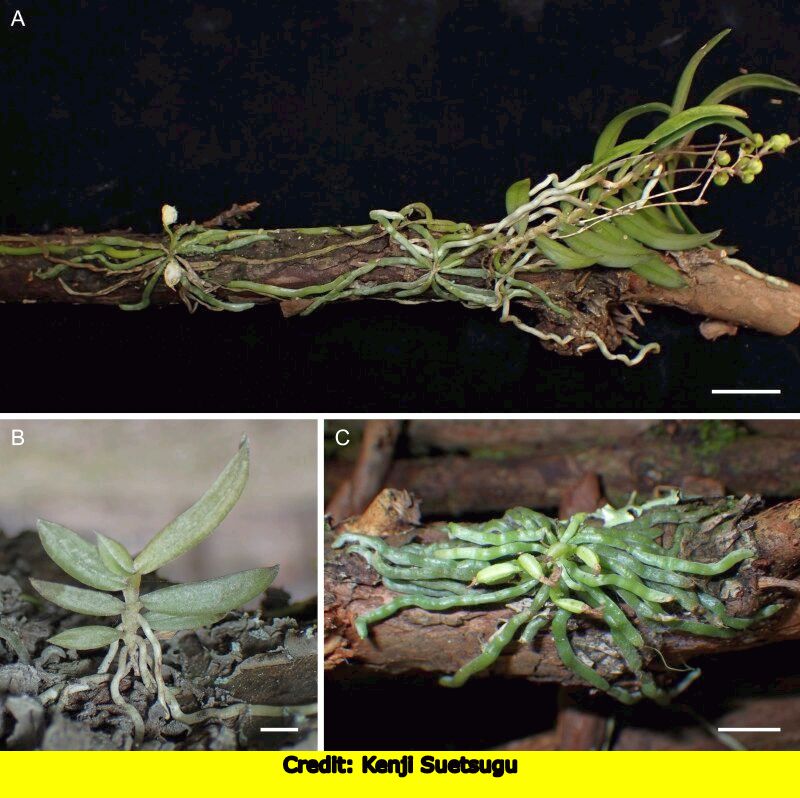
Both the green roots of this leafless orchid and the leaves of a closely related leafy orchid species had significant amounts of photosynthetic pigment, high photosynthetic electron transport activity, nocturnal carbon dioxide uptake, and high photosynthetic gas exchange. Little is known about the photosynthetic activity of leafless epiphytic orchid roots. The goal of the researchers was to compare the photosynthetic properties of leafless epiphytic orchids, Thrixspermum japonicum, with that of aerial roots leafy species Thrixspermum japonicum leaves and roots. The results showed that the photosynthetic efficiency of the roots of the leafless epiphytic orchid is significantly higher than that of the closely related leafy orchid found in the same region. Roots without stomata showed absorption of CO2 in the night, similar to Th. japonicum leaves, most probably facilitated by specialized aeration cells in the roots. These findings contradict commonly-held perceptions about photosynthesis and the typical role of roots.
Access the full paper at https://nph.onlinelibrary.wiley.com/doi/10.1111/nph.18812
7. Stress memory in plants could hold key to growing disease-resistant crops
Biotic stress experienced by plants can be in the form of attacks by herbivorous insects or disease-causing pathogens. Samuel Wilkinson and colleagues from the University of Sheffield, Sheffield, UK, have discovered a mechanism by which plants can develop long-term resistance to different kinds of stresses. Their findings explain the mechanism by which plants “remember” the stress of a previous attack, and how this long-term memory is encoded in a family of “junk DNA” that can act against defence genes for several weeks. Although most animals, including humans, depend on plants for food and feed, either directly or indirectly, they are essentially at the bottom of the food chain. While the animals can move in search of food and shelter, plants cannot move; they are thus extremely vulnerable to attack from all sides, including from insect herbivores and diseases.
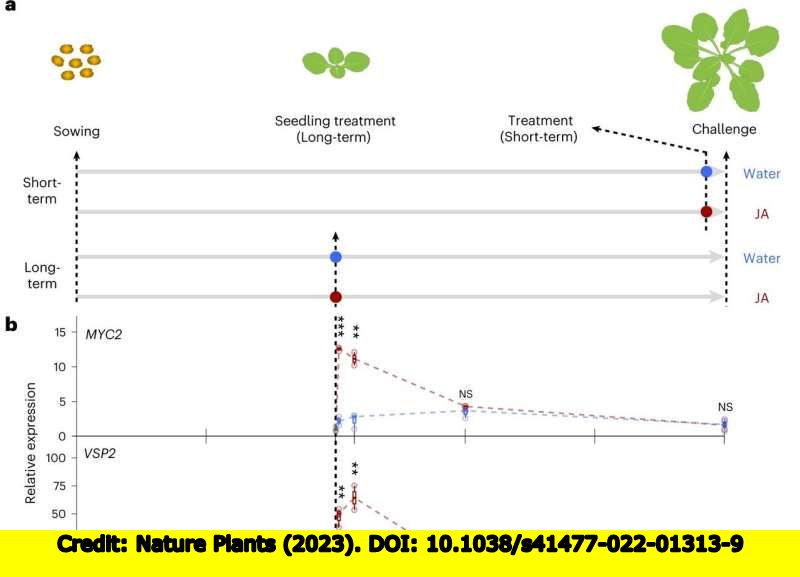
Animals and plants have evolved the ability to acquire immunity by recovering from biotic stress, but they use different mechanisms to do so. The findings also reveal a new epigenetic function of the ‘root DNA’ family. “This knowledge can help us develop new breeding strategies and select plant varieties for food production that are designed to resist pests and diseases,” says Professor Ton, one of the corresponding authors. Although the short-term effects of jasmonic acid on plant defences are well documented, the long-term effects are not, and the team discovered that the immune memory of stress treated with jasmonic acid can last for several weeks and transfer to newly developed leaves, giving long-term resistance to larvae. The study provides the first model of long-term immune memory in plants, and it shows how epigenetic modifications of certain junk DNA families can protect plants from further damage from pests. The findings also represent a valuable research tool to explore the complex mechanisms by which epigenetically altered DNA can prime defence genes within and across plant generations.
Access the abstract at https://www.nature.com/articles/s41477-022-01313-9
8. Traditional horticultural substrate’s sorptive behaviour quantified
The ability of a substrate component (organic or inorganic) to bind and retain water (hydratability and wettability) is important for research and the promotion of efficient water-use practices. Information on such abilities plays a crucial role in designing appropriate protocols for irrigation in protected cultivation (in the glasshouse and greenhouse conditions). It is known that many factors affect the wettability of a material, including the handling of the material. Paul Bartley III from Auburn University, USA, in collaboration with researchers from other universities, carried out investigations to determine the effect of moisture content (MC) on the absorption behaviour of substrates after initial and secondary hydration cycles. The research aimed at quantifying the effect of absorption on substrate wettability and water-holding capacity.

Since hydrophobicity can significantly affect the wetting behaviour of peat, the effectiveness of hydrophilic coconut fibre was tested in mitigating the initial hydrophobicity of the peat substrate. Mixing coconut with peat significantly improved the humidity of the substrate. The statistical approach used in the study to quantify substrate wettability helped to objectively identify the cut point where the substrate approached its maximum water content owing to surface wetting. Data from these experiments show that substrate moisture content and pretreatment can cause differences in initial water recovery efficiency. Future research should focus on changes in absorption behaviour through multiple wetting and drying cycles, such as during crop production, as well as practical solutions to increase substrate water use, such as improving the physical properties of pine bark and mixed substrates.
Access the full paper at https://journals.ashs.org/hortsci/view/journals/hortsci/58/1/article-p79.xml
Potential Crops/Technologies/Concepts
1. Growing mushrooms alongside trees could feed millions and mitigate the effects of climate change
Many of the world’s forests are highly degraded, if not lost altogether, and despite significant afforestation activities, a net loss of forest area remains high, at some 4.7 million hectares per year as per data for the decade, 2010-2020. Demand for agricultural land is the biggest driver of global deforestation, and this is forecast to accelerate from the increased demand not only for agriculture but also for bioenergy crops and other needs. University of Stirling scientists, Paul Thomas and Alistair Jump, have found that growing edible mushrooms alongside trees can produce a valuable food source for millions of people while capturing carbon, mitigating the impact of climate.
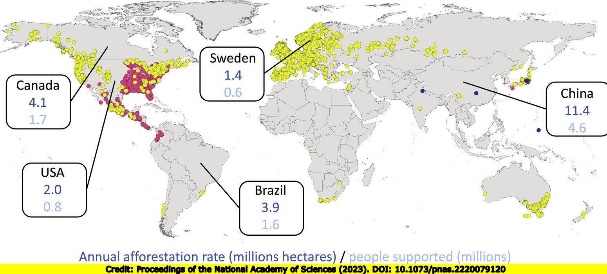
The approach not only reduces the need for deforestation to make way for crops, but it also incentivizes tree planting. The authors discuss how planting mushrooms and trees can help mitigate the effects of climate change. They found that planting mushrooms and trees in forests can help reduce carbon dioxide emissions by up to 30%; it can also help reduce the amount of carbon dioxide in the atmosphere by up to 50%. They explain that mushrooms and trees can absorb carbon dioxide from the atmosphere and store it in them. Additionally, the authors point out that planting mushrooms and trees in forests can help reduce soil erosion and improve soil quality, and it can help increase biodiversity by providing habitats for a variety of species. They suggest that such conservation and development actions can thus realize sustainable benefits through edible mushroom cultivation.
Access the full paper at https://www.pnas.org/doi/10.1073/pnas.2220079120
2. First microneedle-based drug delivers agrochemicals to plants to improve crop quality
As environmental conditions get increasingly influenced by climate change, an increasing human population, limited resources, and reduced availability of agricultural land, the agricultural sector is under pressure to develop precise and sustainable agricultural practices, which enable more efficient and sustainable use of resources. Nutrient systems that effectively deliver trace elements, herbicides, and antibiotics to crops are essential to ensure high productivity and quality products while reducing resource wastage. The currently accepted methods of applying agrochemicals to plants are ineffective. A first-of-its-kind, microneedle-based, drug delivery method for plants has been developed by an interdisciplinary research group of the Singapore-MIT Research and Technology Alliance, an MIT research company in Singapore, led by Daisuke Urano, National University of Singapore, and Benedetto Marelli, Massachusetts Institute of Technology, Cambridge, USA.
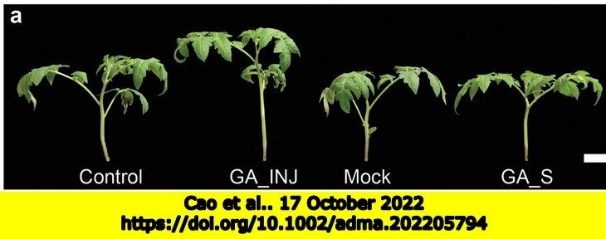
The method is environmentally friendly and less invasive because it transports the substance without any permanent damage to plants. It promotes precision farming methods and provides new resources for plant research and crop trait development, all of which contribute to food security. Researchers used the first polymer microneedles to deliver small compounds into various plants and measured the response of these plants to biomaterial injection. The researchers demonstrated the microneedle’s efficacy in delivering gibberellic acid (GA3), first in Arabidopsis thaliana and then in several monocot and dicot crop species, i.e., tomato (Solanum lycopersicum), lettuce (Lactuca sativa), spinach (Spinacia oleracea), rice (Oryza Sativa), maize (Zea mays), barley (Hordeum vulgare), and soybean (Glycine max). The wide range of plants that can be successfully targeted with microinjectors opens the doors to their use in plant science and agriculture. Large-scale testing out in the fields under different agroclimatic conditions is required to exploit its full potential.
For more, see https://www.natureworldnews.com/articles/55845/20230315/first-microneedle-based-drug-delivers-agrochemicals-plants-improve-crop-quality.htm and https://www.sciencedaily.com/releases/2023/03/230314110734.htm#
Access the full paper at https://onlinelibrary.wiley.com/doi/10.1002/adma.202205794
3. New ‘magic beans’ produce ingredients for cancer treatments, vaccines, and more
New ‘magic beans’ produce ingredients for cancer treatments, vaccines, and more. Since the discovery of DNA in the 1950s, an amazing amount of knowledge about how biology works at the molecular level has been amassed. Now there is the opportunity to use this knowledge to build new living organisms, which have the potential to do new things to solve some of the world’s biggest problems.

Brian DeDecker, at the University of Colorado Boulder, USA, working with members of the CU iGEM student research team, has been trying to develop a type of magic bean that can become a custom chemical factory under genetic instructions. In future, some soybean farms maybe biopharming (Biopharming is the production and use of transgenic plants and animals genetically engineered to produce pharmaceutical substances for use in humans or animals). The DeDecker Lab is investigating the therapeutic health benefits of sprouting bucolic green soybeans. Soybean was chosen as it is remarkably efficient, turning the sun’s energy into a cornucopia of proteins and fats while restoring nitrogen to the soil, rather than stripping it as many crops do. Because it is cheap and nutritionally dense, it’s used broadly as feedstock for cattle. Efforts are underway to infuse soybean with the genetic blueprint to build the natural oil squalene, for which sharks are killed for their livers. Similarly, it should be possible to produce Taxol, or paclitaxel, a widely used chemotherapy treatment, which comes from the bark of yew trees, and avoid cutting down the giant trees. It appears to be the beginning of exploiting the great potential.
For more, see https://www.colorado.edu/today/2023/03/01/new-magic-beans-produce-ingredients-cancer-treatments-vaccines-and-more
4. Agriculture with drones, robots, and AI
Robots and drones, driven by artificial intelligence (AI), are making it in a big way in both agricultural research and farmers’ fields. Although much is talked about AI-powered systems for agricultural research and operations, there have not been many critical publications on the subject (see Artificial Intelligence in the Life Sciences 3, January 2023, 100057; access online at https://www.sciencedirect.com/journal/artificial-intelligence-in-the-life-sciences). (Editor’s note: It must be noted that it will be some time before the technology becomes routinely available to many mid and low-income countries. In addition, how far one should go in adapting AI to replace traditional agricultural practices needs to be explored). Three recent studies on this aspect are briefly described here, while the next two items in this section also describe some varied applications of remote sensing and AI.
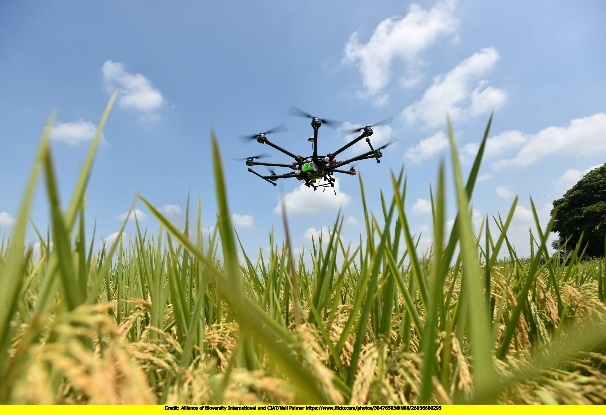
Breeding of cereals is a major preoccupation of agricultural researchers all over the world. However, choosing the best selections is a remarkably difficult task, involving quality traits (breeders’ skills and training) and quantitative aspects (measurements such as grain size, number of warheads per plant etc.). Head (panicle) density is a major component in understanding crop yield, especially in crops that produce variable numbers of tillers, such as sorghum and wheat. Scott Chapman at the University of Queensland, Brisbane, Australia, and colleagues from different countries, explain how deep learning models can be leveraged to assess grain crops more efficiently, and how they also help unlock new functionalities for camera-equipped drones in agriculture.
Researchers from China and Singapore, led by Pichao Liu of the Nanjing University of Posts and Telecommunications, China, have recently developed a method to replace manual rice counting with a much more sophisticated method, involving the use of unmanned aerial vehicles (UAVs) or drones. They proposed a new method for rice plant counting, locating, and sizing (RiceNet), which consists of one feature extractor frontend and 3 feature decoder modules, namely, density map estimator, plant location detector, and plant size estimator. The results suggest that RiceNet can accurately and efficiently estimate the number of rice plants and replace the traditional manual method.
Girish Chowdhary, Erkan Kayacan, and colleagues at the University of Illinois, USA, are developing a semiautonomous robot that gathers and transmits real-time data about the growth and development of crops, information that crop breeders—and eventually farmers—can use to identify the genetic traits in plants likely to produce the greatest yields. The researchers expect that the robot will be a “game changer” for both crop scientists and farmers, automating the labour-intensive phenotyping processes of farming and crop development.
For more, see https://phys.org/news/2023-03-deep-tedious-agricultural-tasks.html?utm_source=nwletter&utm_medium=email&utm_campaign=daily-nwletter and https://phys.org/news/2023-03-drones-deep-technique-quantify-rice.html?utm_source=nwletter&utm_medium=email&utm_campaign=daily-nwletter and https://news.illinois.edu/view/6367/467197
Access the full paper at https://spj.science.org/doi/10.34133/plantphenomics.0017 and https://spj.science.org/doi/10.34133/plantphenomics.0020
5. Researchers examine drought resistance traits in beans using hyperspectral remote sensing
Crops adapt to climate and environmental changes by exhibiting some altered biological characteristics. For example, plants growing in deserts can tolerate drought. However, breeding is often necessary to ensure optimal crop yields, stress response, and water utilization. Proximal remote sensing provides a powerful tool for high-throughput phenotyping for assessing the stress response of plants. A research team, led by Christopher Wong, University of California, Davis, USA, recently tried to overcome this limitation by high-throughput phenotyping tools that are cost-effective for rapid screening. They assessed physiological (stomatal conductance and predawn and midday leaf water potential) and ground- and tower-based hyperspectral remote sensing (400 to 2,400 nm and 400 to 900 nm, respectively) measurements to evaluate drought response in 12 common beans (Phaseolus vulgaris) and 4 tepary bean (Phaseolus acutifolius) genotypes across 3 field campaigns. Tepary beans, which are common in semi-arid and arid environments, tend to be more drought-tolerant than common beans.
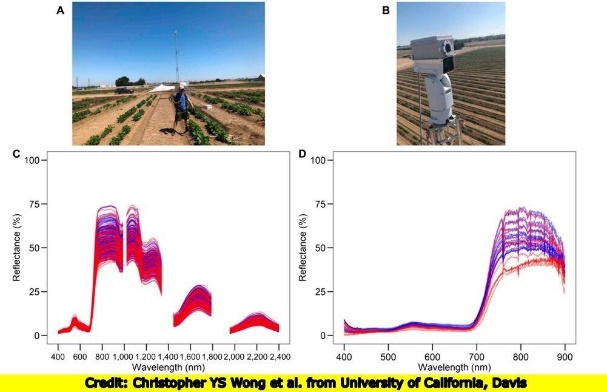
The research team harnessed the power of hyperspectral imaging and extracted information related to specific crop characteristics from different regions of the electromagnetic spectrum, using advanced imaging techniques—both handheld and tower-based. The team found that the ground-based method generally outperformed the tower-based method for all three features—ventral conductivity, predawn leaf water potential (LWP), and midday LWP. The researchers then used the heatmap clusters, primarily to highlight drought response, to characterize drought response phenotypes. This study demonstrates applications of high-resolution hyperspectral remote sensing for predicting plant traits, and phenotyping drought response across genotypes, for vegetation monitoring and screening breeding populations.
Access the full paper at https://spj.science.org/doi/10.34133/plantphenomics.0021
6. Could AI-powered object recognition technology help solve wheat disease?

Fusarium head blight (FHB), also known as Fusarium ear blight (FEB), is a fungal disease of cereals such as wheat, barley, oats, rye, and triticale. FHB is caused by several Fusarium fungi, which infect the heads of the crop, reducing grain yield. In wheat, Fusarium infects the head and causes the kernels to shrivel up and become chalky white. Fusarium wilt causes a lot of economic damage to wheat, and the associated toxin, deoxynivalenol (DON), can cause problems for human and animal health. Hence it is important to try to build resistance and reduce the risk of DON as much as possible,
Jessica Rutkoski and her colleagues at the University of Illinois at Urbana-Champaign, USA, investigated advanced object recognition technology to keep toxin-contaminated wheat kernels out of the food supply, and to help researchers make wheat more resistant to fusarium head blight, or scab disease. The technology helped researchers to predict DON levels better than in-field ratings of disease symptoms. The goal is to create an online portal where breeders could upload cell phone photos of wheat kernels for automatic scoring of fusarium damage. Although further training is needed to improve the capabilities of the neural network, initial tests show encouraging results. They thus demonstrate the potential to provide an automated and objective phenotyping method of Fusarium-damaged kernels (FDKs), which could be widely used to support the development of FHB resistance.
Access the full paper at https://acsess.onlinelibrary.wiley.com/doi/10.1002/ppj2.20065
7. Discovery of root anatomy gene may lead to the breeding of more resilient corn crops

Root anatomical phenotypes are important in the acquisition of soil resources, especially in stressful environments. Understanding the genetic regulation of root anatomical phenotypes promises to accelerate the breeding of crop varieties with improved stress tolerance and carbon sequestration. An international team of researchers, led by Jonathan Lynch at the Pennsylvania State University, USA, have identified a gene that encodes a transcription factor—a protein useful in converting DNA into RNA—which triggers a genetic sequence responsible for developing a key trait that allows the corn roots to reach more water and nutrients. Now, identifying the genetic mechanism behind the trait creates a target for breeding, said Lynch. Researchers dug up and cleaned the roots of thousands of corn plants in Pennsylvania, Arizona, Wisconsin, and South Africa, to analyse their phenotypes.
The researchers created several mutant corn lines using genetic manipulation techniques such as the CRISPR/Cas9 gene editing system and gene deletions over 10 years to show a causal relationship between the transcription factor and aerenchyma formation in the root cortex. The researchers report that functional studies showed that a mutant corn line containing the bHLH121 gene, and a CRISPR/Cas9 mutant line in which the gene was altered to suppress its function, both showed reduced aerenchyma formation in the root cortex. Understanding the genetic regulation of root anatomical phenotypes promises to accelerate the breeding of crop cultivars with improved stress tolerance, resilience, and carbon sequestration.
For more, see https://www.psu.edu/news/research/story/discovery-root-anatomy-gene-may-lead-breeding-more-resilient-corn-crops/
Access the full paper at https://www.pnas.org/doi/10.1073/pnas.2219668120
News:
1. Biopesticides should be preferred over chemical pesticides for fall armyworm control, study suggests
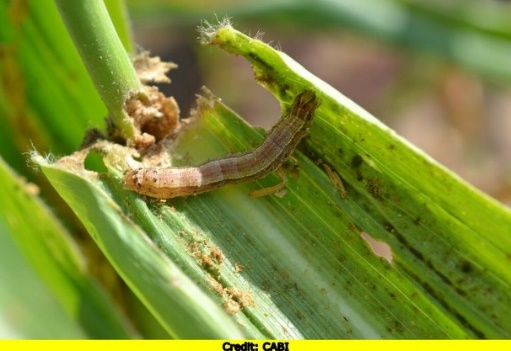
The fall armyworm is a major pest of maize and other crops in Africa, and it has caused significant economic losses in agriculture. An outbreak of the fall armyworm, Spodoptera frugiperda, in Africa has led to several recommendations against pesticides, including biopesticides. However, the effects of these products on the environment, especially on parasites, have not been evaluated in the field. CABI scientists, led by Lakpo Koku Agboyi, Accra, Ghana, investigated the effects of commonly used biopesticides on S. frugiperda management, and on its larval parasitoids, in northern Ghana. The researchers note that the traditional methods of controlling the fall armyworm have included the use of chemical pesticides, but that these methods have been expensive and have had negative environmental impacts. Biopesticides are derived from natural sources, such as bacteria, fungi, and viruses, and they can be used to control pests without harming the environment. The study found that biopesticides were effective in controlling the fall armyworm and that they were more cost-effective than chemical pesticides. The study also found that biopesticides had no negative impact on non-target organisms, such as bees and other pollinators. Biopesticides are an environmentally friendly alternative to chemical pesticides, and they can be used to control other pests as well. The researchers conclude that biopesticides are easy to use and can be deployed quickly and efficiently in fields.
Access the full paper at https://link.springer.com/article/10.1007/s10340-023-01590-z
2. Global development’s glaring blind spot: The power of smallholder women farmers
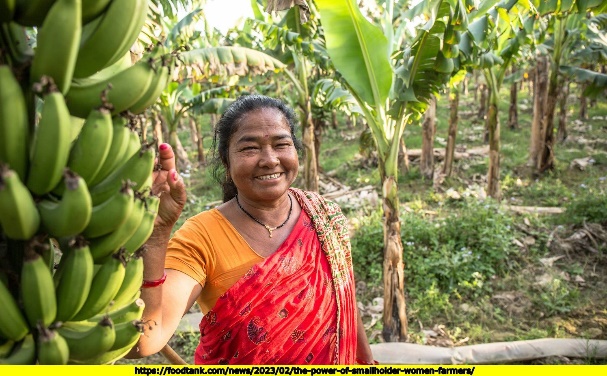
Smallholder farmers produce up to 80% of the food in the countries of Asia and sub-Saharan Africa. Women are crucial producers on those farms. They steward their animals and land with minimal resources, striving for sustainability, nutritious food, and financial security. It is an uphill battle, made worse by the combined impacts of climate change, regional conflicts, and a cost-of-living crisis, which has plunged 828 million people across the world into chronic hunger. Surita Sandosham, CEO of Heifer International in 2022, discusses the role of smallholder women farmers in sustainable agriculture. She explains that smallholder women farmers are an important part of the agricultural sector in many developing countries and that they play a critical role in ensuring food security and reducing poverty. She points out that smallholder women farmers face many challenges, such as lack of access to land, credit, and markets, but that they have the potential to be powerful agents of change. Smallholder women farmers are more likely than men to adopt sustainable agricultural practices, such as agroforestry, intercropping, and crop rotation. In addition, smallholder women farmers are more likely than men to use organic fertilizers and conserve soil and water resources. Surita goes on to explain that smallholder women farmers are often excluded from decision-making processes in agriculture and that this limits their ability to contribute to sustainable development. Empowering smallholder women farmers can lead to more sustainable agriculture, and it can thus help reduce poverty and hunger. Thus, there is a need for greater investment in smallholder women farmers, and for policies that support their participation in sustainable agriculture.
For more, see https://foodtank.com/news/2023/02/the-power-of-smallholder-women-farmers/
3. Global food system emissions imperil Paris climate goalsGreenhouse gas (GHG) emissions by the global food system are said to add nearly one-degree Celsius to Earth’s surface temperatures by 2100 on current trends, obliterating Paris Agreement climate goals, scientists warned. Catherine Ivanovich and colleagues from Columbia University, New York, have developed an inventory for global food consumption GHG emissions, separated by individual gas species and employing a reduced-complexity climate model, for evaluating the associated future warming contribution and potential benefits from certain mitigation measures. A major overhaul of the sector—from production to distribution to consumption—could reduce those emissions by more than half, even as the global population rises. The researchers explain that food production and consumption are responsible for a significant portion of global greenhouse gas emissions and that these emissions are increasing at an alarming rate. They note that the Paris climate agreement aims to limit global warming to 1.5 degrees Celsius above pre-industrial levels and that this goal cannot be achieved without significant reductions in food emissions. The article cites a study that found that, if current trends continue, food emissions could account for up to 70% of the global emissions budget by 2050. The study also found that reducing food emissions would require significant changes in food production and consumption patterns. The article explains that reducing food emissions would require changes, such as reducing meat consumption, reducing food waste, and increasing the use of renewable energy in food production. The article notes that reducing food emissions would have many co-benefits, such as improving public health and reducing deforestation. Finally, the article calls for greater action to reduce food emissions and for policies that support sustainable food systems. (Editor’s note: We should note that food is the most essential life-giving activity among all human economic activities, in addition to it being livelihood for a billion or more. If one reads through the full article, it becomes clear that the meat and dairy industry, along with rice, account for the maximum GHG emissions; such emissions by other crops are considerably less.)
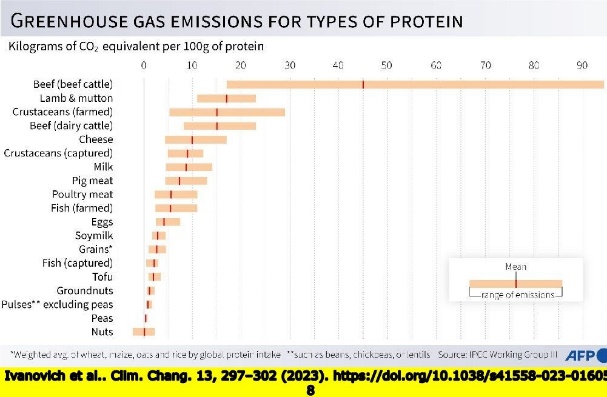
Access the full paper at https://www.nature.com/articles/s41558-023-01605-8
4. Can gene discovery methods halt the global march of the wheat blast?
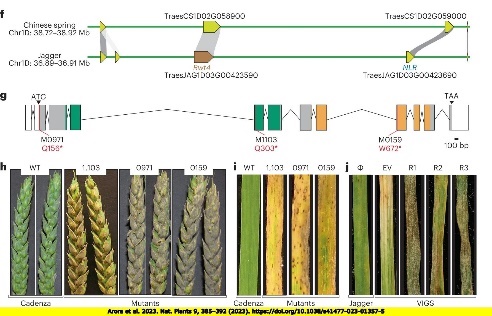
Wheat blast, caused by the fungal pathogen Magnaporthe oryzae, was first identified in Brazil in 1985 because of “host jumping” by ryegrass. It has left a trail of destruction on three continents since it was first reported in 1985, and it is now considered a major threat to global wheat security. Therefore, finding and deploying resistance genes against this pathogen is crucial to mitigate this threat. An international research effort, led by Paul Nicholson at the John Innes Centre, UK, has used innovative genome discovery methods to show how we can stop this emerging and highly destructive disease. They used Watkin’s collection, collected from around the world in the 1930s and consisting of more than 300 wheat lines, or landraces, which contain the disease-fighting diversity that existed in wheat before intensive breeding.
Greenhouse experiments using wheat plants that had lost the function of these resistance genes showed that they were sensitive to wheat blast isolates, confirming that genes Rwt3 and Rwt4 protected the plants from the blast. Dr Sanu Arora, the first author of the study, said: “The devastating impact of wheat in the wheat belts of South America, South Asia, and Africa is a wake-up call for Europe”. It is not certain if the disease is already in Europe or not, but it could potentially spread through human migration or seed through import. Hence it is very important to protect this vital crop from the threat. This study highlights the importance of maintaining Rwt3 and Rwt4 in wheat cultivars/landraces in genetic resource collections, to avoid future host jumps.
Access the full paper at https://www.nature.com/articles/s41477-023-01357-5
5. Seaweed holds many potential benefits for mankind, and for our planet
Seaweed is highly nutritious and an increasingly popular ingredient in cuisines all over the world. It is an excellent source of iodine, a vital trace mineral that plays a critical role in thyroid health. Seaweed also contains many antioxidants in the form of some vitamins (A, C, and E) and protective pigments. (see https://www.webmd.com/diet/health-benefits-seaweed). According to Professor Catriona Macleod, seaweed is increasingly seen as a solution to many of the world’s most pressing problems. Interest in farming seaweed has exploded. There is such a wide range of applications, from fertilizers to food, animal feed, cosmetics, and pharmaceuticals. Seaweed has carrageenans, agars, and fucoidans, which act as prebiotics, non-digestible fibres that feed the healthy bacteria in the human gut, which may improve gut health.
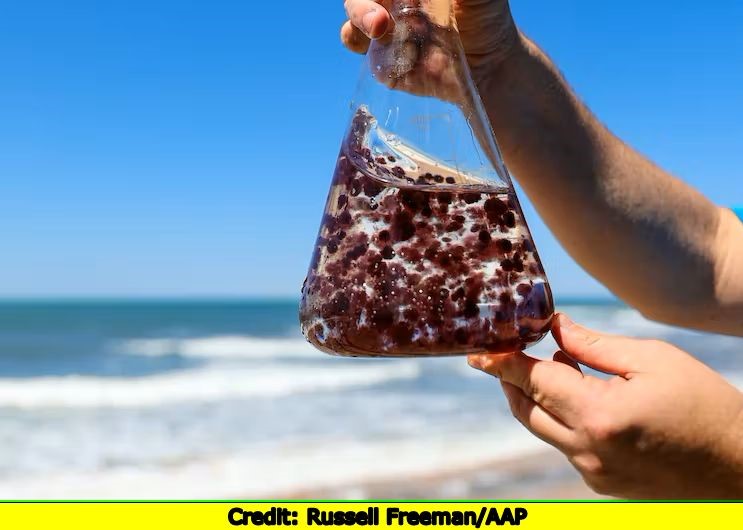
Early studies suggested that scaling up seaweed aquaculture could make a big difference in climate change by capturing carbon dioxide emissions. But it turns out it’s not as simple as that. Verifying whether the carbon dioxide fixed by seaweed through photosynthesis can be locked up long-term is extremely complex. There are differences between species and ecosystems and interactions of the various organisms that live on and around seaweed communities, as well as the prevailing environmental conditions. In some situations, seaweed ecosystems produce more carbon than they can capture. They can be used to make new products to replace other materials with a larger carbon footprint. This includes new foods, new materials such as fabrics, and new building materials designed to store carbon in the long term. There are still several challenges to overcome, and issues to be resolved. Through a coordinated and appropriate R&D effort, involving teams of scientists at national and international levels, there is a possibility of exploiting seaweed for the good of the planet.
For more, see https://theconversation.com/can-seaweed-save-the-world-well-it-can-certainly-help-in-many-ways-201459
6. Regenerative agriculture needs a standardized definition, says a new report
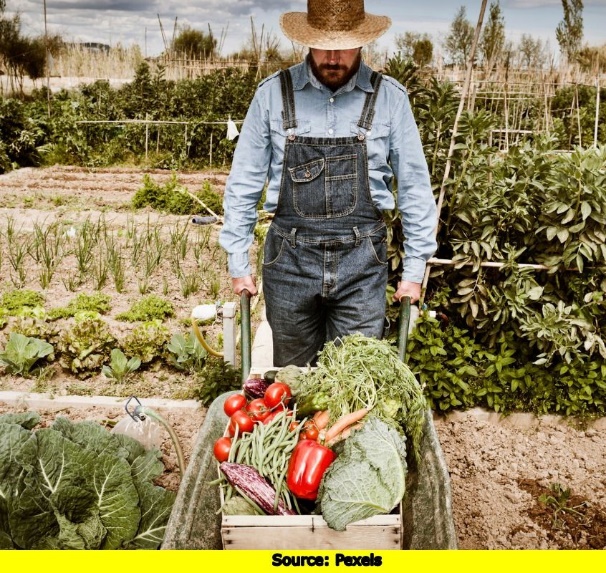
An inconsistent understanding of what regenerative agriculture entails and what it can achieve hinders an outcome-based framework for measuring and evaluating regenerative agriculture practices, a new report says. The non-profit Food and Land Use Coalition describes itself as a coalition of ambassadors, donors, national forums and partners, which strives to embrace diverse opinions and approaches, support disruptive thinking, and build evidence-based consensus. It released a new report titled, “Linking Regenerative Agricultural Practices to Human, Nature, and Climate Outcomes,” which calls for a performance-based framework for measuring and evaluating renewable agricultural practices. Regenerative agriculture practices are generally accepted to encompass boosting soil wellness, increasing water permeation and retention, improving farm resilience, and reducing dependence on chemical inputs. However, there is currently no universally accepted definition for the term.
The report includes a review of evidence on how specific regenerative agricultural practices link to three important farm-level outcomes: biodiversity, climate change mitigation, and yield. It found that while many regenerative agricultural practices can have a positive impact on on-farm biodiversity and on-farm carbon sequestration, effects on yield are highly variable and effects on net greenhouse gas emissions were mixed. The Report provides recommendations for stakeholders to shift to regenerative agricultural practices. Policymakers must eliminate support measures that encourage unsustainable agricultural practices, agricultural expansion, and land conversion; set laws and regulations for land conversion; and repurpose agricultural subsidies to support more sustainable farming practices. Businesses, in partnership with farmers, need to set outcome-based targets to drive the adoption of practices that are suitable to local contexts, but also tackle wider system issues at landscape and global levels; and they should make data and evidence readily available to the public. Research and academia, civil society, and donors also play critical roles in providing the resources needed to help address the gaps in evidence and bring different stakeholders together.
For more, see https://www.greenqueen.com.hk/regenerative-agriculture-needs-standardized-definition-report/
Access the full report at https://www.foodandlandusecoalition.org/knowledge-hub/regenag-people-nature-climate/
7. Agriculture needs a fresh approach to tackle the growing problem of insect resistance to biopesticides, new study finds
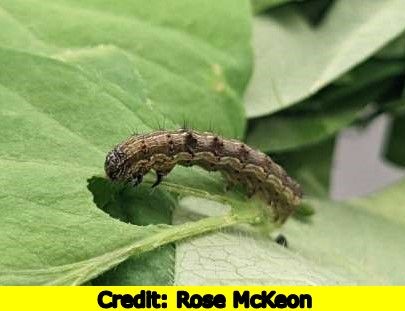
Environmentally sustainable pesticides, such as microbial biopesticides, are increasingly replacing chemical pesticides in plant protection. Most drivers of pesticide resistance involve chemical pesticides and transgenic crops, and they are not intended to address resistance to microbial biopesticides, containing live pathogens. The unique characteristics of the host-parasite interaction offer new opportunities to proactively manage the risk of developing biopesticide resistance in pests. Rosie Mangan at the University of Stirling, UK, and her colleagues investigated this phenomenon, and they report that genotype-specific interactions (GEIs) can have a particularly large effect on pathogen resistance: the fitness of a resistance allele depends on many aspects of the host environment. According to them, insect pests which attack crops have extraordinary powers to develop resistance to greener pesticides, and a new way to manage resistance risks is needed. They note that biopesticides can delay the development of resistance in insects and pests when incorporated into an integrated pest management program. By promoting crop heterogeneity across the landscape and diversifying the biopesticides available to farmers, we can use GEIs to minimize resistance risks and maintain biopesticide efficacy.
For more, see
Access the abstract at https://www.cell.com/trends/ecology-evolution/fulltext/S0169-5347(23)00016-2?_returnURL=https%3A%2F%2Flinkinghub.elsevier.com%2Fretrieve%2Fpii%2FS0169534723000162%3Fshowall%3Dtrue
8. Sweet potato clones with improved insect resistance and weed tolerance identified
Weed management is consistently ranked among the top priorities of the United States sweet potato industry. Amaranth species can reduce yields up to 85% in sweet potatoes, and many other weed species result in losses from 18% to 96%. Conventional sweet potato growers use herbicides, between-row cultivation, mowing, and hand-weeding. If these are not done properly, weeds will come up in the middle of the rows. Mechanical weed control is a common practice, using multiple tillages during field preparation and two to three cultivations during the growing season. However, none of these is completely satisfactory. Phillip Wadi and colleagues from USDA/ARS, Charleston, USA, investigated the possibility of a sustainable approach for weed and insect management in sweet potato breeding for weed and insect tolerant/resistant clones. To provide additional weed and insect management strategies for sweet potatoes, researchers initiated the development of insect-resistant germplasm that also has weed tolerance, by breeding and selecting sweet potato clones that are fast-growing and have semi-erect to erect canopy architecture. Two sweet potato clones, USDA-17-037 and USDA-17-077, were consistent across both years and had the lowest weed counts, exhibited enhanced insect resistance, and were the highest-yielding entries. They demonstrated that the combination of germplasm that is both resistant to insect pests and competitive with weeds can provide organic and subsistence sweet potato growers solutions to these critical issues.
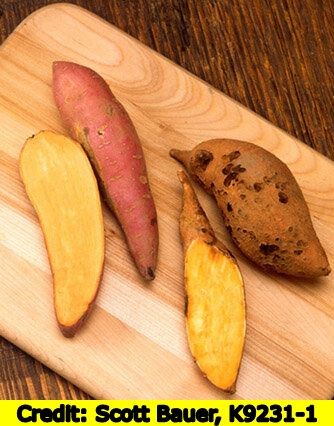
Access the full paper at https://www.cambridge.org/core/journals/weed-technology/article/sustainable-approach-for-weed-and-insect-management-in-sweetpotato-breeding-for-weed-and-insect-tolerantresistant-clones/BB8AEF6DBFDE0FF92EF7F1E525E00E9B
9. At least 80% of the world’s important sites for biodiversity on land already have conflicting human activity
The world faces a biodiversity crisis, and we have covered this in many past issues in this newsletter. The impact of infrastructure development on biodiversity has also been widely highlighted. Residential and commercial development, transport, energy production, mining, and dams are identified as threats to almost half of the threatened species on the IUCN Red List for which threats have been documented (see https://www.iucnredlist.org/). Ashley Simkins at the University of Cambridge, UK, and colleagues examined the prevalence of current and potential future infrastructure within the global network of 15,150 terrestrial Key Biodiversity Areas (KBAs), using a range of open and commercial spatial datasets related to infrastructure. They further elaborate on how these activities are threatening biodiversity and how it is important to protect biodiversity hotspots around the world. Several of the biodiversity hotspots around the world with considerable biodiversity of plant, bird, mammal, reptile, and amphibian species (see https://www.adda247.com/upsc-exam/list-of-biodiversity-hotspots-in-the-world/) lie outside the current system of protected areas.
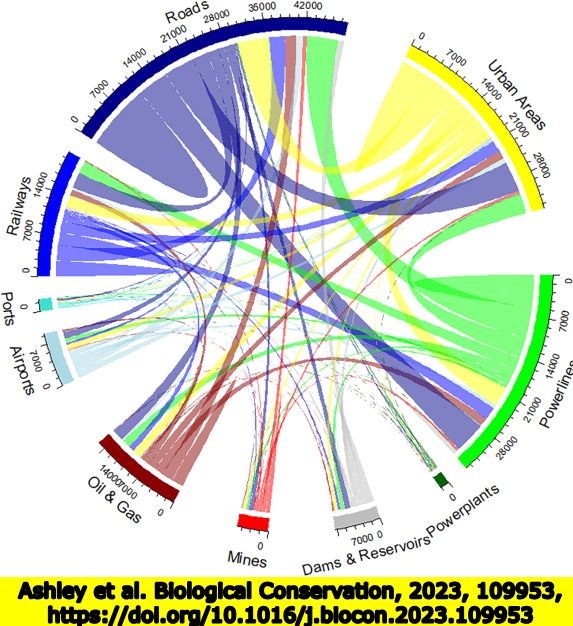
The researchers found that these hotspots are under threat from human activities, such as deforestation and mining, in addition to climate change. These hotspots are important for human survival as they provide ecosystem services, such as clean air and water, food, and medicine. They found that infrastructure worldwide is widespread in these sites and its prevalence is likely to increase. This is the first-ever assessment of the presence of infrastructure in KBAs, a global network of thousands of internationally recognized sites that are being built for economic development. KBAs need stronger safeguards to avoid the negative impacts of further development. (Editor’s note: Despite commitments by most countries of the world—and signing of treaties or agreements by several of them—to conserve 30% of the land, infrastructural activities are damaging the biodiversity-rich areas. It is worth noting that this situation does not arise mainly from the encroachment of land by agriculture. The big question remains: how are countries going to achieve 30% of their land protected in the next few decades? Of course, more research is required to corroborate these findings, and to determine more precisely the negative impacts of infrastructure development activities, to move ahead with appropriate conservation actions).
Access the full paper at https://www.sciencedirect.com/science/article/pii/S0006320723000538?via%3Dihub
Events: (November 2023)
1. ICABDC 2023: International Conference on Agricultural Biotechnology and Developing Countries

06-07 November 2023, Cape Town, South Africa
For more, see https://waset.org/agricultural-biotechnology-and-developing-countries-conference-in-november-2023-in-cape-town
2. ICCAAF 2023: International Conference on Climate Action in Agriculture and Forestry

06-07 November 2023, Amsterdam, the Netherlands
For more, see https://waset.org/climate-action-in-agriculture-and-forestry-conference-in-november-2023-in-amsterdam
3. ICCCM 2023: International Conference on Climate Change Mitigation
November 13-14 2023, Istanbul, Türkiye

For more, see https://waset.org/climate-change-mitigation-conference-in-november-2023-in-istanbul
4. ICMRI 2023: International Conference on Multidisciplinary Research and Innovation

20-21 November 2023, Jeddah, Saudi Arabia
For more, see https://waset.org/multidisciplinary-research-and-innovation-conference-in-november-2023-in-jeddah
5. ICSFAIT 2023: International Conference on Smart Farming and Agricultural Internet of Things

20-21 November 2023, Jeddah, Saudi Arabia
For more, see https://waset.org/smart-farming-and-agricultural-internet-of-things-conference-in-november-2023-in-jeddah
6. ICSCPC 2023: International Conference on Sustainable Crop Production and Consumption

27-28 November 2023, Singapore, Singapore
For more, see https://waset.org/sustainable-crop-production-and-consumption-conference-in-november-2023-in-singapore
Other Topics of Interest
1.Bigger flowers, greater rewards: Plants adapt to climate disruptions to lure pollinators
Access the full paper at https://academic.oup.com/evlett/advance-article/doi/10.1093/evlett/qrad006/7072662?login=false
2. Are your strawberries bland? Pesticides could be to blame
Access the abstract at https://pubs.acs.org/doi/10.1021/acs.jafc.2c08157
3. Breaking myths surrounding the seed sector
For more, see https://seedworld.com/breaking-myths-surrounding-the-seed-sector/
4. Improving the sustainability and value of cotton’s natural fibres
5. Mixing varieties of cotton to produce non-flammable fabrics
Access the full paper at https://journals.plos.org/plosone/article?id=10.1371/journal.pone.0278696
6. Pulses are packed with goodness: Five cool things you should know about them
For more, see https://theconversation.com/pulses-are-packed-with-goodness-five-cool-things-you-should-know-about-them-198903
7. The new protein-based biosensor detects potato and tomato crop disease
For more, see https://www.jns.org/new-protein-based-biosensor-detects-potato-and-tomato-crop-disease/
Access the full paper at https://onlinelibrary.wiley.com/doi/10.1111/tpj.16071
8. Nitrogen addition affects trait divergence of plant community assembly
Access the abstract at https://link.springer.com/article/10.1007/s11104-023-05910-1
9. You can turn your backyard into a biodiversity hotspot
10. A better metric for prioritizing the conservation of ‘evolutionarily distinctive’ species
Access the full paper at https://journals.plos.org/plosbiology/article?id=10.1371/journal.pbio.3001991
11. Use of algae to support sustainable fertilizer production
Access the full paper at https://www.sciencedirect.com/science/article/pii/S138589472300164X?via%3Dihub
12. Do conventional crops reduce biodiversity as advocacy groups claim? Is modern plant breeding necessary? Examining populist views on modern agriculture
13. Dual Domestications and Origin of Traits in grapevine evolution
14. Plant roots fuel tropical soil animal communities
For more, see https://www.sciencedaily.com/releases/2023/03/230307174312.htm#
Access the full paper at https://onlinelibrary.wiley.com/doi/10.1111/ele.14191
15. With over 8 billion mouths to feed, it’s time to innovate
For more, see https://seedworld.com/with-over-8-billion-mouths-to-feed-its-time-to-innovate/
16. To stay resilient, the seed needs to innovate
For more, see https://seedworld.com/to-stay-resilient-seed-needs-to-innovate/
17. Using AI to see how well past extinctions can predict future biodiversity loss
Access the full paper at https://royalsocietypublishing.org/doi/10.1098/rsos.221507
18. Crop yields reduced by climate extremes finds study
Access the full paper at https://www.nature.com/articles/s41598-023-29378-2
19. India’s sacred groves are resurrecting a vanishing forest
20. Study reveals seasonal peak photosynthesis hindered by late canopy development in northern ecosystems
Access the abstract at https://www.nature.com/articles/s41477-022-01278-9
21. How Vietnam is trying to stop rice warming the planet
For more, see https://phys.org/news/2023-03-vietnam-rice-planet.html?utm_source=nwletter&utm_medium=email&utm_campaign=daily-nwletter
22. Male-sterile sorghum may offer dairy cows needed energy with less water use
23. Wild relatives are plant breeders’ insurance policy for food security For more, see https://seedworld.com/wild-relatives-are-plant-breeders-insurance-policy-for-food-security/
24. Biodiversity Conservation and indigenous knowledge systems
For more, see https://www.epw.in/engage/article/biodiversity-conservation-and-indigenous-knowledge
25. Genomic analyses provide important insights for conservation management
Access the full paper at https://www.cell.com/action/showPdf?pii=S0168-9525%2823%2900020-3
26. How plants are inspiring new ways to extract value from wastewater
For more, see https://phys.org/news/2023-01-ways-wastewater.html?utm_source=nwletter&utm_medium=email&utm_campaign=daily-nwletter
Access the full paper at https://nph.onlinelibrary.wiley.com/doi/10.1111/nph.18762
27. Study reveals optimal time to apply eco-friendly biopesticides to tackle Oriental migratory locust pest
Access the full paper at https://www.frontiersin.org/articles/10.3389/fphys.2023.1110998/full
28. “Open Source” seeds loosen Big Ag’s grip on farmers
For more, see https://reasonstobecheerful.world/open-source-seeds-offer-a-way-out-of-big-ags-grip-on-farmers/
29. Integrated grafting system developed for passion fruit plantlets
Access the full paper at https://journals.ashs.org/hortsci/view/journals/hortsci/58/2/article-p170.xml
30. Major palm oil companies broke their promise of No Deforestation – recovery is needed
For more, see https://theconversation.com/major-palm-oil-companies-broke-their-promise-on-no-deforestation-recovery-is-needed-198399
31. Forest loss globally threatens biodiversity hotspots: study
For more, see http://www.china.org.cn/china/2023-03/19/content_85177386.htm
Access the full paper at https://www.cell.com/one-earth/fulltext/S2590-3322(23)00085-4?_returnURL=https%3A%2F%2Flinkinghub.elsevier.com%2Fretrieve%2Fpii%2FS2590332223000854%3Fshowall%3Dtrue
32. Conserving biodiversity could alter crop production
For more, see https://eos.org/articles/conserving-biodiversity-could-alter-crop-production Access the full paper at https://onlinelibrary.wiley.com/doi/full/10.1111/gcbb.13016
33. Alpaca-derived antibodies could protect plants from disease
Access the abstract at https://www.science.org/doi/10.1126/science.abn4116
